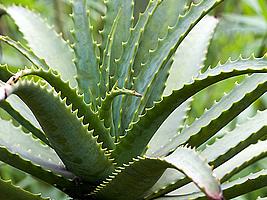Krantz Aloe (Aloe arborescens) is a highly versatile and popular succulent plant, known for its medicinal, cosmetic, and landscaping applications. It has a shrubby growth habit, reaching heights of 1.6 to 9.8 feet (about 0.5 to 3 meters). The plant features a branched stem with a woody base. The leaves are arranged in a rosette pattern, long, fleshy, bluish-green in color, and edged with sharp, tooth-like thorns. When cut, the leaves reveal a clear, gel-like sap. Krantz Aloe blooms in winter, producing tall, erect, and showy inflorescences. These inflorescences are racemose, with numerous tubular flowers in red, orange, or yellow, attracting hummingbirds and bees. The fruits are capsule-type.
The widespread cultivation and popularity of this plant worldwide are unsurprising, given its many attributes. In gardens, with its decorative leaves and shapes, Krantz Aloe is used for dense mass plantings, arrangements with other plants, or even in rows. It is particularly suitable for rock or arid gardens, in compositions with cacti and other succulents, and for defensive hedges.
This succulent is also an essential addition to the medicinal herb garden, as it is an effective and rapid treatment option for burns, skin irritations, and abrasions, not to mention its other therapeutic and cosmetic properties. It is considered as rich in active ingredients as its relative, Aloe vera, the medicinal aloe. Krantz Aloe grows moderately to quickly and requires little maintenance and care, making it a good choice for beginner gardeners. Caution: Krantz Aloe can be allergenic for some people, and its consumption is not recommended without medical supervision.
Krantz Aloe should be grown in full sun or partial shade, in well-drained, light soil enriched with organic matter, and watered at regular intervals. It is extremely hardy and capable of tolerating extreme conditions such as drought, infertile soils, high altitudes, cold, sudden temperature changes, and winds. It adapts to a wide range of climatic conditions, from subtropical to equatorial regions. However, it does not withstand strong frost. Propagation is through the separation of offshoots around the mother plant, leaf or stem cuttings, and more rarely, by seeds sown in spring.


